Solar wind is a fascinating phenomenon that involves the release of significant amounts of energy in space. It occurs through a singular mechanism, which includes flares on the Sun and other stars, storms in the Earth’s magnetosphere, and the creation of northern lights. These events are all connected by a process known as magnetic reconnection. In this article, we will delve into the scientific understanding of solar wind and explore its various aspects.

1. What is solar wind? And where does it come from?
The Sun has been under mankind’s observation since ancient times. Despite our extensive research, there are still unexplained phenomena. One of these mysteries is the origin of the high-speed solar wind.
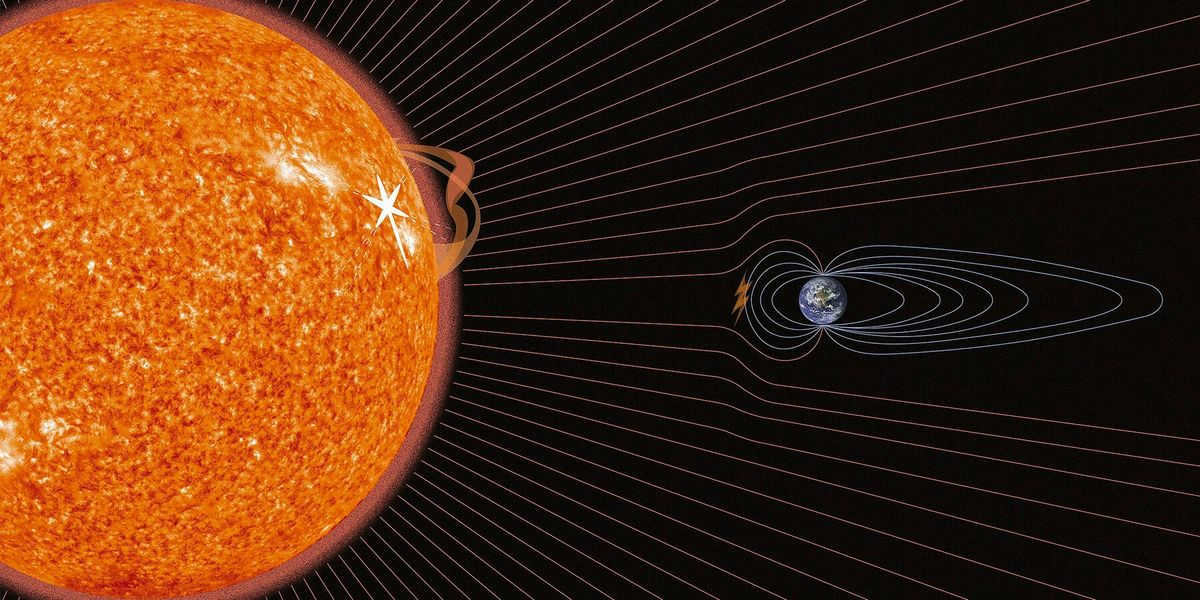
The phenomenon known as the solar wind refers to a continuous stream of charged particles that emanate from the Sun. These particles exist in a plasma state and are carried along by the Sun’s magnetic fields. When the solar wind encounters the outer reaches of space, it is able to permeate through and travel further. If the Earth happens to intersect with the solar wind’s path, the plasma particles from the Sun’s magnetic field interact with our planet’s own magnetic field. This interaction occurs when the solar wind, which is traveling at speeds greater than 500 km/s (faster than the speed of sound under similar conditions!), collides with the Earth’s magnetosphere. As a result of the Earth’s magnetic field exerting pressure on the plasma particles, they abruptly come to a halt. This sudden stoppage creates an area of highly concentrated plasma at the magnetosphere’s boundary. It is at this point that a magnetic storm commences.
2. What causes the solar wind to occur?
Plasma is a unique state of matter that exists at temperatures of around 10,000 degrees and higher. At such high temperatures, the atoms become separated: the negatively charged electrons and positively charged ions are unable to bind together, resulting in an ionized gas where the total negative charge is balanced by the total positive charge. The Sun, with its core temperature of approximately 16 million degrees Kelvin, contains a significant amount of plasma.
What is the source of energy for plasma particles to overcome the gravitational field of the Sun and travel at supersonic speeds? How do the winds interact with the Earth’s magnetosphere? These questions do not have definite answers. However, it is believed that magnetic reconnection plays a role – a phenomenon in which magnetic field lines with opposite directions are broken and reconnected in a highly conductive plasma. This process can effectively convert the energy stored in magnetic fields into the energy of charged particles.
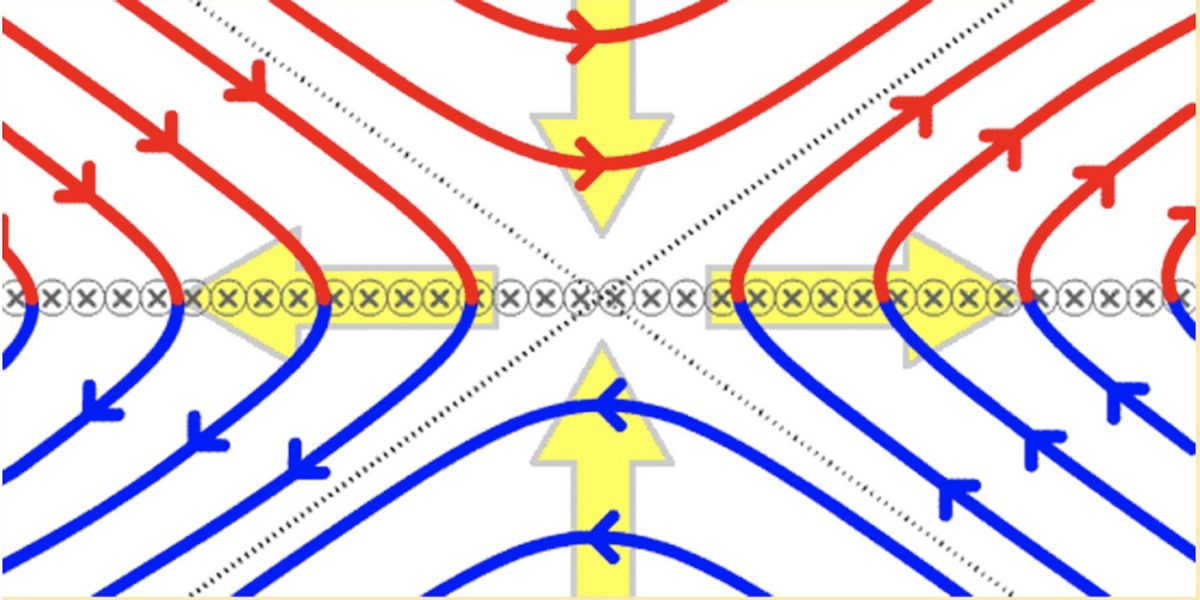
3. What causes magnetic field lines to break?
The tearing of magnetic field lines can be likened to the behavior of a regular rubber band. When a rubber band is not stretched, it is unable to hold multiple pencils together. However, when the rubber band is stretched, it utilizes the energy from its tension to securely hold the pencils. The more the rubber band is stretched, the greater its energy. If the rubber band is stretched beyond its limit, it will tear and quickly release that energy.
Magnetic fields, similar to rubber bands, have the ability to store energy when they are stretched. In the past, scientists believed that magnetic field lines were unbreakable, regardless of how much they were stretched. Unlike a rubber band, a single magnetic field line cannot break due to the fact that a magnetic field does not have any free ends. However, if there is another magnetic field line nearby that is also under tension and pointing in the opposite direction, the two lines can break and join together, resulting in the absence of any free ends. This process releases an enormous amount of energy.
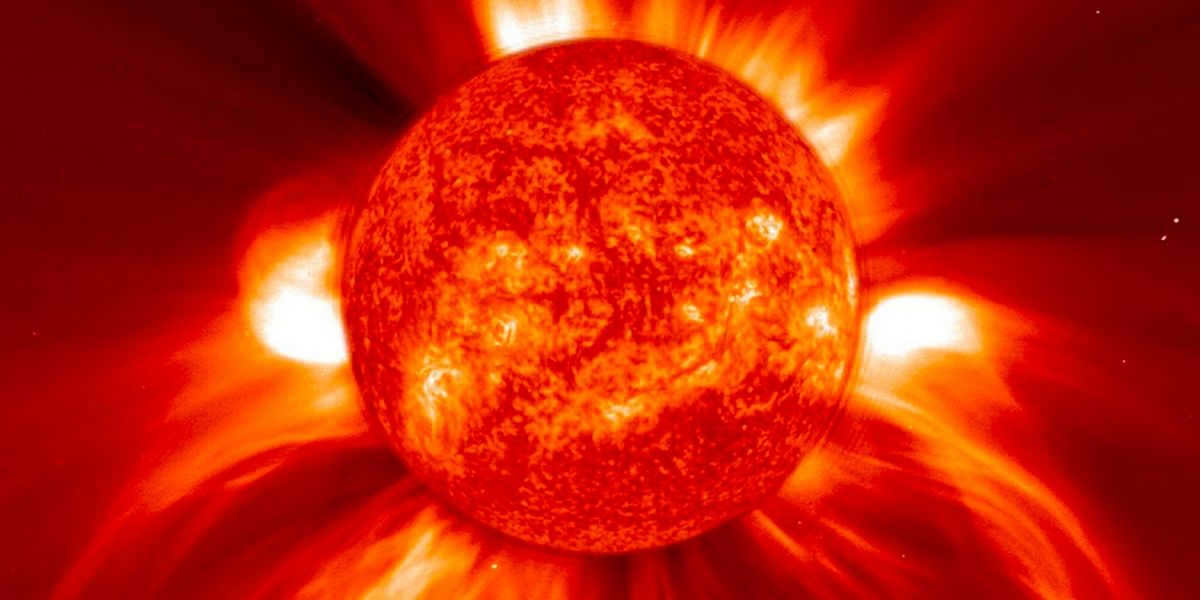
4. Where is magnetic reconnection observable?
The original purpose of introducing the concept of magnetic reconnection was to explain the interaction between the solar wind and the Earth’s magnetosphere. However, subsequent observations have shown that magnetic reconnection can also occur on the Sun itself and other celestial bodies. This phenomenon is responsible for coronal mass ejections on stars, bursts of magnetic energy in the jets of neutron stars and black holes, as well as in magnetospheres.
Recently, it has been discovered that magnetic reconnection can also take place on the surface of the Earth, particularly in plasma-holding fusion reactors. This occurrence is concerning in the context of fusion reactors, as it has the potential to disrupt plasma confinement and release a significant amount of magnetic energy, which could potentially cause damage to the reactor. However, the influx of energy resulting from magnetic reconnection could be harnessed for beneficial purposes, such as powering the plasma engines of spacecraft.
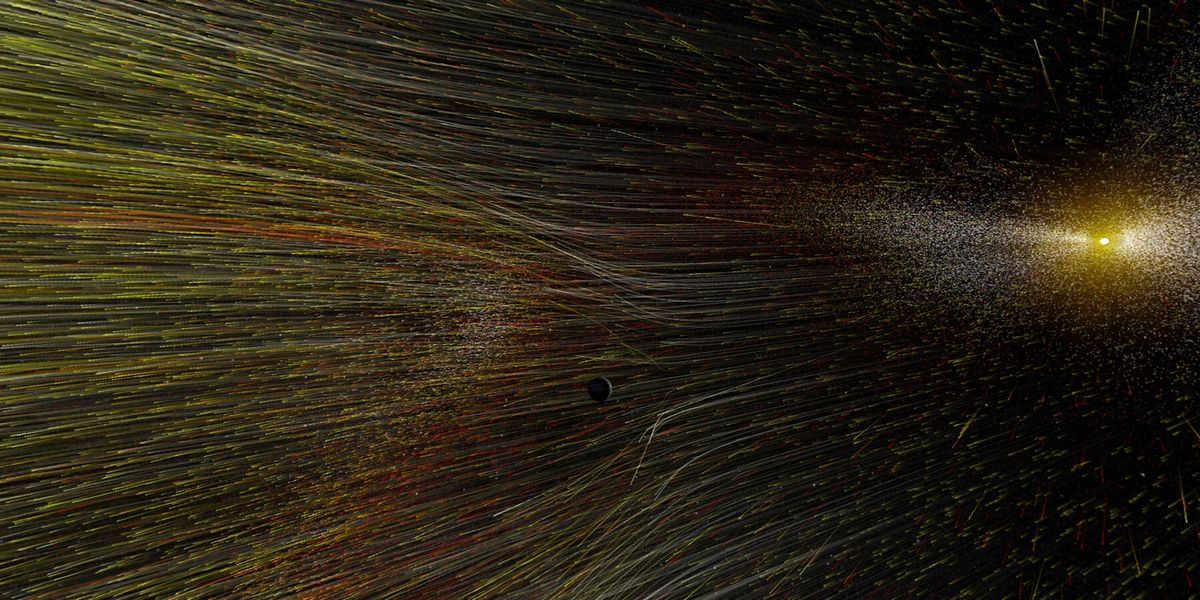
5. What is the reason for the lack of answers to inquiries regarding the solar wind?
The history of magnetic reconnection is full of unknowns. For a considerable period, the Parker model served as a representation of this process. It postulates that the influx of plasma and magnetic field at the point where magnetic lines intersect and break is balanced. This balance is achieved through collisions between electrons and positively charged ions in the boundary layer between oppositely directed magnetic fields. However, contemporary research conducted in solar conditions suggests that plasma particles rarely collide with each other. Consequently, it becomes evident that Parker’s model is not applicable to larger systems, such as most of space physics. Therefore, a new model needs to be developed to address these systems.
6. How can our understanding of solar plasma and magnetic reconnection be applied?
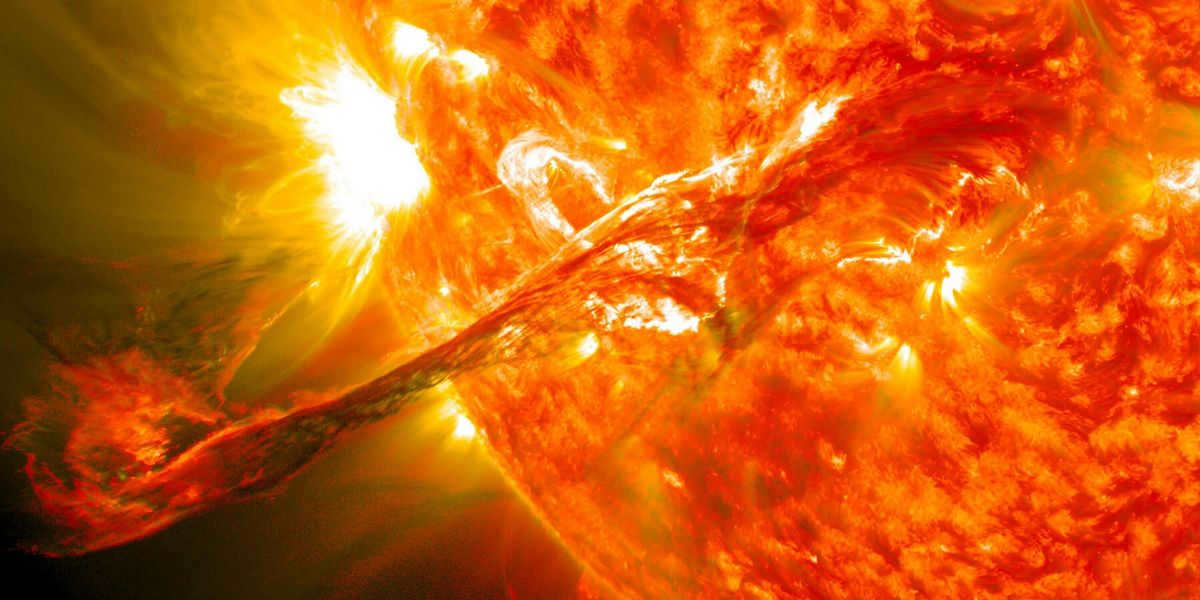
The mechanisms responsible for the energy balance of magnetic reconnection are still not fully understood. The processes by which electrons and ions gain energy on a large scale, as well as the laws that determine the rate of magnetic reconnection, remain unclear. These answers are crucial for predicting space weather, designing fusion devices, and developing plasma engines. Solving the puzzle of magnetic reconnection will require the expertise of scientists in the coming years.
Moving streams of air are commonly known as wind. This phenomenon is observed not only on Earth but also on other planets and even stars. Researchers have discovered that solar wind exists and have demonstrated its direct impact on weather patterns and even human well-being. Learn more about the nature of this phenomenon in the article on 24CMI.
What is the phenomenon of solar wind?
The solar wind is a stream of charged particles that are continuously released from the upper atmosphere of the Sun. It consists mainly of electrons and protons, although it also contains small amounts of other elements. The solar wind is responsible for many phenomena in the solar system, including the auroras seen on Earth and the tails of comets.


The solar wind consists of ionized particles that are emitted by the Sun. These particles are released in various directions and are made up of hydrogen-helium plasma. The temperature of the Sun’s corona is extremely high, causing the electrons and ions within it to move at incredible speeds. Due to these high speeds, the gravitational forces are unable to keep the particles in place, resulting in some particles escaping into space.
It is important to differentiate the phenomenon of solar wind from sunlight. Solar wind refers to a stream of ionized particles, while sunlight refers to a stream of non-charged photons that travel at a constant speed of up to 300,000 km/s and reach the Earth in 8-16 seconds.
What is the speed at which the solar wind “blows”?
It is important to note that the term “blows” is not entirely appropriate when describing this phenomenon, as the solar wind is not similar to Earth’s wind – we are not referring to air, but rather to streams of stellar material. Ionized particles travel at a speed of 400 kilometers per second, occasionally reaching speeds of 500-800 km/s.
Scientists classify the solar wind into two types:
- Slow – dense, formed by the expansion of ionized gases near the equator of the star. The streams of plasma from the corona can reach speeds of up to 400 km/s due to dynamic processes.
- Fast – originating from coronal holes. These flows are emitted towards Earth for a period of 27 days, which coincides with the star’s complete revolution around its axis.
Scientists have observed disturbed currents with speeds ranging from 1000-1200 km/s. These streams are caused by coronal emissions and can lead to magnetic storms.
Impact on Earth
The solar wind is not uniform – as the star rotates, fast and slow streams intersect with Earth. These fluctuations in particle velocity can have a negative effect on the planet’s magnetosphere, resulting in magnetic storms, the aurora borealis, and other phenomena.
When ionized particles transfer energy to atmospheric gases, they produce a glowing effect known as the aurora borealis. Additionally, when energetic charged particles are trapped and held by the planet’s magnetic field, a radiation belt is formed.
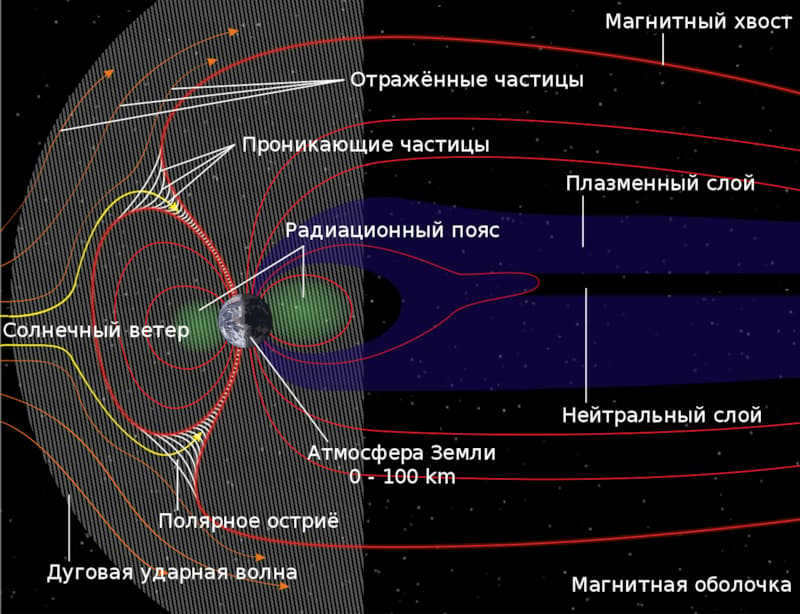

The occurrence also impacts the climate, including the formation of storm fronts. On days when charged particles reach the Earth, there is a higher probability of lightning formation in the atmosphere. Additionally, since satellites monitor solar activity, the study’s findings aid in predicting the likelihood of a severe thunderstorm.
A team of scientists has provided evidence for the effect of this phenomenon on the human body. Researchers from the SB RAS Shafer Institute in Russia conducted an analysis of the frequency of medical assistance requests over a specific time period and discovered that individuals with heart and vascular conditions experienced a higher frequency of worsened well-being during days of magnetic storms.
Protecting the limits of our solar system
The solar wind presents both a threat and a necessity for Earth, as it helps shield our solar system from more devastating cosmic forces. The flow of charged particles displaces interstellar gas and forms a heliopause, a barrier of hot plasma, where the solar wind collides with cosmic rays. This region attenuates radiation from distant stars and supernova explosions.
In 2018, NASA launched the Voyager 2 spacecraft, which successfully crossed the heliopause. During its journey, the probe gathered valuable data about the temperature in this area, revealing that it can reach a scorching 31,000 °C at the outer edge of the solar system. This surprising finding exceeded scientists’ previous calculations, leading them to conclude that the impact of the solar wind colliding with cosmic rays is far more intense than previously believed.
Exploring the Phenomenon
In the 19th century, the concept of the solar wind was initially introduced by British astronomer Richard Carrington in 1859. Carrington made this observation when studying a solar flare and noticing that a geomagnetic storm occurred on Earth the following day. This correlation led Carrington to propose a possible link between these two phenomena.
After seven decades, scientists have been able to determine the temperature of the Sun’s corona, which is an astounding one million degrees Celsius. This finding was initially observed by British geophysicist Sidney Chapman, who noted that at similar temperatures, gases dissipate heat hundreds of thousands of kilometers away from Earth’s orbit. German scientist Ludwig Biermann also contributed to the study of this phenomenon in astronomy by proving the existence of solar wind through observations of comets in our solar system. Biermann noticed that the tails of these comets were directed away from the Sun, suggesting that they were being affected by the pressure exerted by particles in the solar wind.
The term “solar wind” was coined in 1958 by American scientist Eugene Parker. Parker, an astronomer, examined the research of Birman and Chapman and made an observation: the solar corona has such high thermal conductivity that the temperature of its upper layers remains hot even at a distance from the core of the sun where gravity is weakening. As a result, helium nuclei, protons, and electrons that compose the “wind” are able to escape into interstellar space.


The hypotheses gained evidential support in 1959. The investigation occurred aboard the Luna-1 station launched by the USSR. And in 2016, NASA’s STEREO observatory successfully captured the actual process of ionized particle streams.
Magnetic storms in the new millennium
During his research, Carrington, who was mentioned earlier, observed a correlation between solar flares on the central star of our solar system and changes in the Earth’s magnetosphere. In September of 1859, this astronomer documented a magnetic storm that was the most intense ever recorded in the history of studying this phenomenon and was subsequently named the “Carrington Event”.
The scientist documented the presence of sunspots on the surface of the star. The solar flare triggered a coronal mass ejection that reached the Earth’s surface in just 18 hours, instead of the expected 3-4 days. This geomagnetic storm, which began on September 1, 1859, caused disruptions to telegraph systems in Europe and the United States, and even led to sightings of the aurora borealis in the Caribbean.
In March 1989, a different geomagnetic storm took place, marking it as the most potent one since the start of the space era, which researchers named the “Quebec Darkness.” In the Canadian province that shares the same name as the event, electricity generators malfunctioned, resulting in a power outage for 6 million individuals. This incident provided undeniable evidence of a direct connection between solar flares and the functioning of machinery.
During July 2012, yet another formidable coronal eruption happened. This geomagnetic storm matched the strength of the Carrington Event. Luckily, the section of the solar atmosphere where the flare emerged was facing away from the Earth.
Exciting possibilities for energy sources
The use of solar wind as a potential energy source has captured the attention of researchers. Scientists at Washington State University are exploring the idea of employing 8400-kilometer solar sails to harness wind energy, with the goal of generating 1 quintillion GW of power. In addition, they are studying the turbulence associated with this phenomenon to gain insights into achieving stable plasma conditions, which would greatly simplify the process of achieving thermonuclear fusion.
When we envision the Sun, we typically think of a radiant sphere of light in the vastness of space, radiating heat and light to all the celestial bodies orbiting around it. However, the Sun is far more dynamic than that, thanks to the solar wind.
Advertisement
Initially, the concept of the “solar wind” may seem paradoxical, but it is actually a fascinating occurrence originating from our Sun. So, what exactly is it and how does it impact life on Earth?
Thankfully, the solar wind poses no direct threat to our planet, but it does play a significant role in creating one of the most renowned natural phenomena globally. As a result, you are likely more acquainted with the solar wind than you realize.
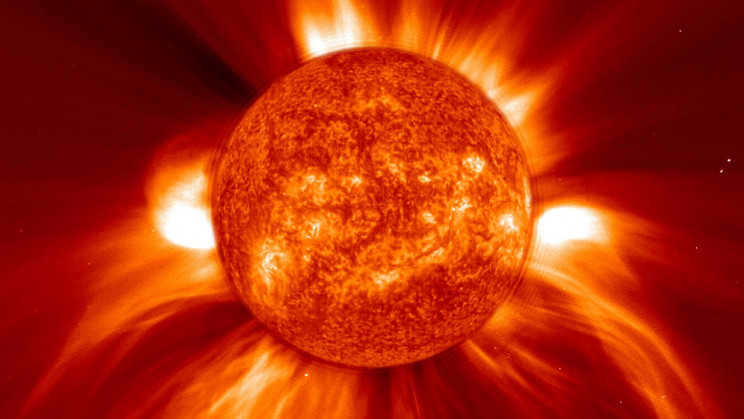
Coronal mass ejection. ESA/NASA/Soho
What does solar wind represent?
The solar wind is an uninterrupted stream of charged particles that originates from the solar corona and extends into outer space. It is generated by the release of plasma from the surface of the Sun, which is caused by the intense heat resulting from nuclear fusion reactions occurring within the star. This heat creates a tremendous external pressure that counteracts the inward gravitational pull of the Sun. This equilibrium between the expanding plasma and the compressive force gives rise to the Sun’s outer atmosphere, known as the corona. The solar wind occurs when the heat and pressure from beneath overpower gravity, allowing charged plasma within the corona to escape into space along the Sun’s magnetic field lines.
Advertisement
This phenomenon occurs throughout the surface of the Sun, and as the Sun rotates, it leads to the curling of its magnetic field lines around its poles. Consequently, as charged particles emanating from the Sun traverse along these magnetic field lines, they are propelled into space in an uninterrupted flow along this spiral pathway.
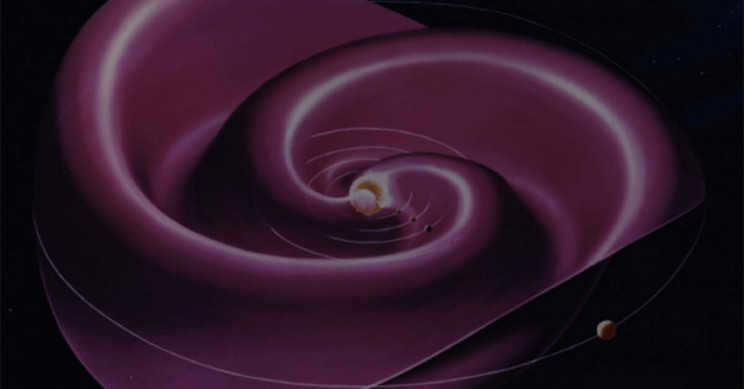
Original Source: NASA.
Is the solar wind similar to a traditional wind?
The solar wind consists of charged particles, so it is not identical to the wind we experience on Earth. However, there are still notable similarities between the two phenomena. While the solar wind is continuously generated, its intensity varies unlike the consistent winds on Earth.
During periods of low activity in the 11-year solar cycle, when occurrences such as coronal holes and sunspots are less frequent, the solar wind can be likened to a gentle breeze. Conversely, during times of heightened solar activity, the solar wind exhibits a much more intricate nature.
Although the similarity can be drawn between this phenomenon and seasonal variations in Earth’s climate, such as the occurrence of hurricanes or snowy winters in high latitudes, the comparison becomes more intricate due to the presence of charged particles in the wind. Nonetheless, a more direct resemblance to Earth’s wind is evident in the fact that the solar wind is typically expelled from the sun at a rate almost twice as fast in the polar regions as it is near the equator.
Advertisement
The formation of regions of high and low density occurs when the high-speed wind interacts with the low-speed wind, resulting in a difference in velocity. These interactions create what is known as corotational interaction regions, which are characterized by increased densities and intense magnetic fields. To draw a comparison, these regions can be likened to storm fronts on Earth. This is why they are referred to as space weather.
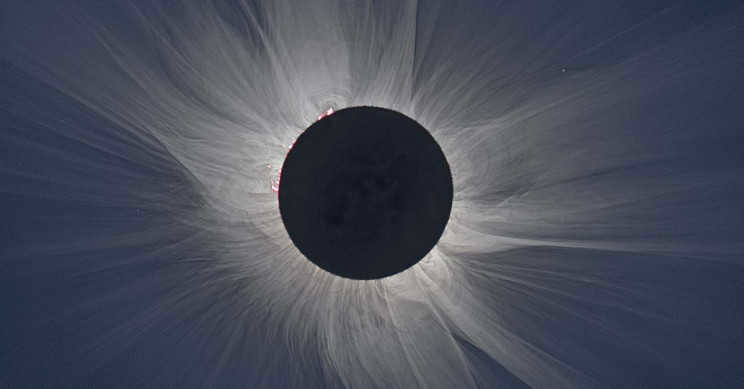
Image showing the solar corona in white light during a total solar eclipse Source: M. Druckmüller/NASA.
What does the solar wind consist of?
The Sun is primarily composed of hydrogen atoms, but nuclear fusion results in the creation of various other elements, which collectively form the solar wind. The majority of the solar wind comprises ionized hydrogen (individual protons and electrons), while ionized helium accounts for less than 10%.
The processes occurring in the core of the Sun are extremely intricate, to say the least. Through the fusion of hydrogen and helium with other particles, various elements such as lithium, beryllium, carbon, oxygen, nitrogen, silicon, and even iron are formed. These elements can all be detected in the solar wind, albeit in small proportions compared to the overall composition. Notably absent are atoms with an equal number of electrons and protons. The solar wind, as it traverses the solar system, is held together by magnetic field lines, which keep electrons and ionized particles in close proximity.
advertisement
What is the effect of the solar wind?
The solar wind is a flow of highly charged particles moving at speeds of hundreds of kilometers per second. While we are specifically referring to electrons and individual charged ions, mainly consisting of hydrogen, it cannot be underestimated that the solar wind has a significant impact.
Nevertheless, it is important to keep in mind that we are discussing a substantial number of charged particles being emitted from the surface of the Sun. If you have ever observed a total solar eclipse, you would have witnessed a brilliant ring of fire surrounding it – that is the solar corona. These fiery tendrils, extending into space, can extend for millions of kilometers, eventually transforming into the solar wind.
If a single burst of solar wind were to hit Earth from this distance, we would barely feel its impact (except for some specific phenomena, which we will discuss later). However, it is important to note that the solar system is not affected by just one particle interaction. We are constantly bombarded by a continuous stream of protons and electrons, and all of these particles interact with each other and different atoms.
Over time, these processes can lead to severe consequences. According to scientists, approximately 3 billion years ago, Mars possessed an atmosphere that closely resembled that of Earth. However, today, there is hardly anything left of it. Researchers now believe that the continuous flow of charged particles has effectively eradicated Mars’ atmosphere. The absence of a protective atmosphere may have caused the primitive lakes and oceans on the red planet to evaporate, resulting in a desolate and lifeless world. The solar wind affects everything in the solar system to some extent, though certain objects, like Earth, are more resilient to its influence.
A recent research conducted by the College of Earth, Ocean and Atmospheric Sciences at Oregon State University proposes that the Earth’s magnetic field may have originated from a prehistoric magma ocean located in the depths of the planet’s mantle.
How does the Earth protect itself from the solar wind?
Luckily, Earth has a unique defense mechanism in the form of its iron-rich solid inner core and liquid outer core. These components work together like a powerful dynamo, generating a robust magnetic field that surrounds the planet. The solar wind, which is composed of charged particles, interacts strongly with this magnetic field, causing it to follow the lines of the Earth’s magnetic field rather than bombarding the planet directly.
Without this strong magnetic field, Earth would likely resemble present-day Mars, and it’s possible that life would have never progressed beyond simple archaea and single-celled organisms before our planet became uninhabitable in its current state.
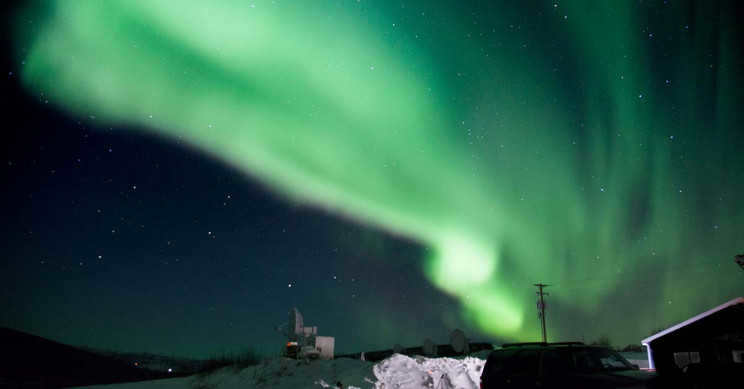
The Northern Lights were seen in the sky above Alaska in 2017. The photo was taken by NASA’s Terry Zaperach.
What happens when the solar wind reaches Earth?
While Earth’s magnetic field is strong enough to deflect most of the solar wind, some particles are still able to penetrate it in areas where the magnetic field lines intersect with Earth’s magnetic poles.
These particles interact with the atmosphere and create the mesmerizing display of light known as the Aurora or Polar Lights. They are typically observed at the highest latitudes near the Arctic and Antarctic circles. However, during periods of increased solar wind activity, such as during the peak of the solar cycle, these auroras can also be seen at lower latitudes.
That’s not to say that solar wind hasn’t posed challenges for us recently. In the past, our interaction with solar wind was limited to the appearance of auroras, before widespread use of electricity and the invention of electronics. However, as we became increasingly reliant on electricity to power our modern world, solar wind became a much more significant issue.
Furthermore, solar wind can have unpredictable effects on the environment, even if it doesn’t directly cause destruction. We are just beginning to understand the full extent of its impact. For instance, SpaceX experienced the loss of approximately 40 new Starlink satellites shortly after launch, when powerful solar winds interacted with the Earth’s atmosphere and caused it to expand.
The satellites were disabled and burned up in the dense atmosphere due to a sudden and dramatic increase in atmospheric drag caused by this geomagnetic storm, which prevented them from reaching their intended orbit.

In 2018, Eugene Parker, the physicist from the United States who discovered the solar wind in the 1950s, attended NASA’s preliminary briefing on the solar probe project named after him. Source: NASA/Kim Shiflett
Discoverer of the solar wind
It is quite surprising that the connection between the solar wind and two incredible celestial events, auroras and total solar eclipses, went unnoticed until 1957 when Eugene Parker, an American physicist, made the discovery.
Just a few years later, NASA’s Mariner II spacecraft, en route to Venus, received data that confirmed Parker’s predictions, and his theory quickly became widely accepted among scientists. As technology advanced and satellites were launched into orbit, we were able to gather even more detailed information about the solar wind and its characteristics.
“Many of Parker’s original ideas and theories have been proven correct by subsequent space missions, and his research has greatly influenced our understanding of the interactions between the Sun and Earth,” NASA stated. “Now, more than fifty years later, the Parker Solar Probe presents a unique opportunity to observe and study the phenomena that Parker first proposed, and to further our knowledge of solar physics and magnetic fields surrounding stars.”
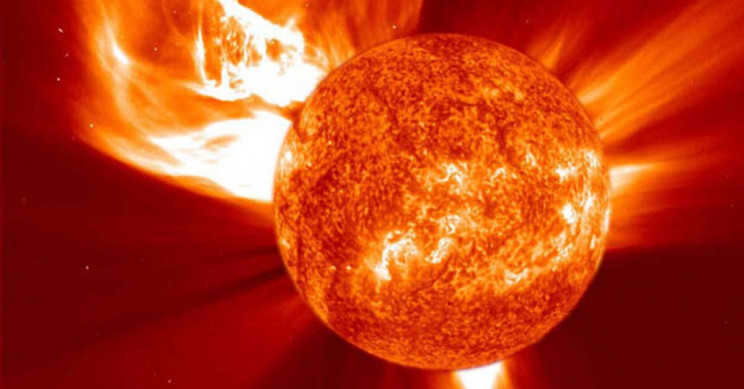
Solar flares and solar wind have some similarities, but they are distinct phenomena that differ in several important ways. While solar flares are sudden bursts of electromagnetic radiation in the Sun’s atmosphere, they are not associated with particle eruptions. The exact cause and relationship between solar flares and solar wind are still not fully understood. This information is sourced from SOHO (ESA/NASA).
What sets solar flares apart from solar wind?
Despite their similar names, solar flares and solar wind are completely different. Solar flares are localized eruptions of electromagnetic radiation in the Sun’s atmosphere, while solar wind refers to the continuous flow of charged particles from the Sun’s corona into space.
Furthermore, they are generated through a distinct mechanism compared to the solar wind. While there is ongoing discussion surrounding this matter, the prevailing belief is that solar flares emerge within highly magnetically active areas of the solar atmosphere. These events occur when charged particles are accelerated to nearly the speed of light and subsequently interact with the Sun’s plasma.
One potential explanation for this occurrence is magnetic reconnection, a physical phenomenon where intense magnetic field lines come into contact and rearrange themselves. As a result, magnetic energy is converted into kinetic and thermal energy, thereby causing a sudden acceleration of charged particles, notably electrons.
One explanation for how this process occurs on the Sun is that solar arcades, which are dense series of coronal loops, form along magnetic field lines. These arcades then connect magnetically to another arcade, resulting in the formation of a magnetic spiral that becomes suddenly disconnected. This disconnection causes a massive release of energy in the form of electromagnetic radiation, which manifests as a solar flare.
The reason why solar flares are often associated with solar wind is because of a phenomenon that sometimes occurs after a solar flare. Following the burst of energy in the corona, there can be a sudden eruption of charged plasma from the corona in the direction of the solar wind. This event is known as a coronal mass ejection.
To draw a comparison, a coronal mass ejection can be likened to a tornado while the solar wind is akin to a pleasant summer day at the beach. The majority of our concerns regarding space weather, such as satellite disablement, power grid disruption, and even internet disruption, are primarily connected to coronal mass ejections.
The amount of plasma that can be expelled into space during a coronal mass ejection is significantly greater than that of the most active solar wind. If a substantial coronal mass ejection were to strike Earth at this very moment, it would overpower the Earth’s magnetic field and release powerful streams of charged particles onto the planet.
Let me clarify, apart from individuals with pacemakers or comparable medical devices, the impact of a coronal mass ejection (CME) would be negligible on our daily lives. The majority of people would not even notice any changes, except for the occasional bewildered gaze at the sky above Ecuador, where auroras would suddenly illuminate the atmosphere. It is worth noting that scientists assert that throughout the Earth’s existence, which spans over 4.5 billion years, it has experienced numerous CMEs without any detrimental effects on our survival.
However, we reside in a modern era, and considering the frequency and probability of such events, it is highly likely that another significant CME will occur in the near future, perhaps sooner than anticipated. It is crucial that we adequately prepare for this inevitability, and an essential aspect of our readiness involves studying space weather and comprehending the solar wind’s role in shaping our solar system.
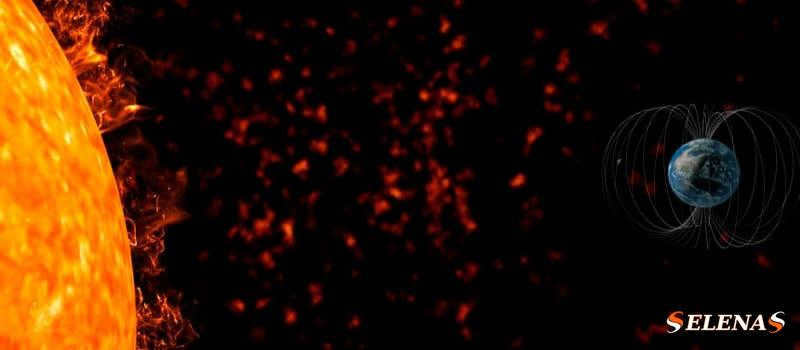
Today, let’s discuss the solar wind and its impact on our planet.
The solar wind refers to the steady flow of protons and electrons emanating from the Sun’s outer atmosphere, known as the corona.
These charged particles travel through space at velocities ranging from 250 miles (400 kilometers) per second to 500 miles (800 kilometers) per second in a plasma state, as reported by the National Space Weather Prediction Center.
Upon reaching Earth, the solar wind propels a stream of charged particles into the magnetosphere and along the magnetic field lines towards the poles.
When these particles interact with the Earth’s atmosphere, they create vibrant auroras over the polar regions.
The concept of solar wind was originally suggested by the pioneering astrophysicist Eugene Parker, whose name is associated with NASA’s Parker Solar Probe mission.
As stated by the University of Chicago, Parker was serving as an assistant professor at the University of Chicago in 1957 when he recognized that an excessively hot solar corona would theoretically release charged particles at high velocities.
This excessive heating is one of the most enigmatic aspects of the Sun’s behavior, and solar physicists still lack a complete understanding of why the Sun’s atmosphere is hotter than its surface.
Parker’s hypothesis posited that the plasma in the solar corona is consistently heating up, with temperatures in this region reaching an astonishing 3.5 million degrees Fahrenheit (2 million degrees Celsius).
The Sun’s gravity eventually reaches a point where it is unable to contain the plasma, resulting in its expulsion into space as the solar wind. Along with the plasma, the Sun’s magnetic field is also carried away.
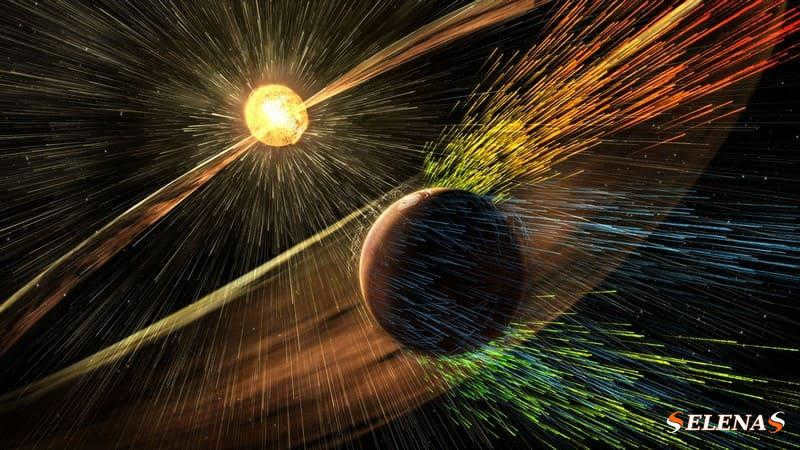

The Sun’s outer atmosphere continuously emits the solar wind. This artistic representation portrays the solar wind originating from the Sun.
In 2018, Parker reminisced about the widespread criticism his theory faced during its inception.
One of the initial reviewers of his article remarked, “I would strongly advise Parker to conduct thorough research on the subject before attempting to write a paper, as it appears to be complete nonsense.”
Finally, astrophysicist Subrahmanyan Chandrasekhar provided support for Parker’s theory, which later led to the naming of NASA’s Chandra X-ray Observatory in his honor.
According to the University of Chicago, Chandrasekhar accepted Parker’s theory despite his dislike for the concept of particles because he couldn’t find any flaws in Parker’s calculations.
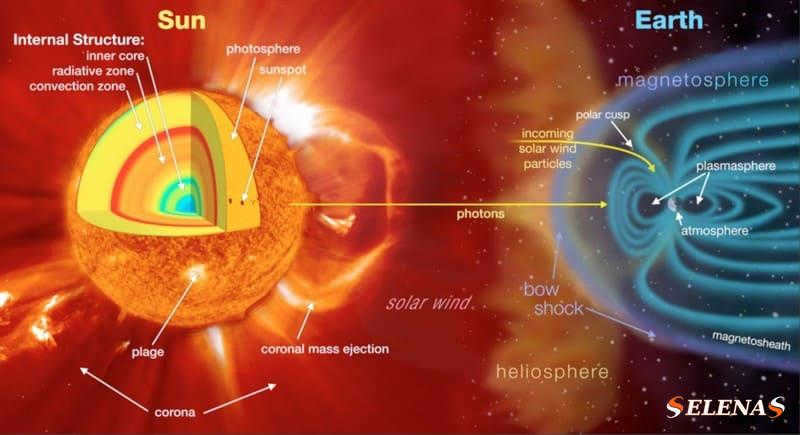
The Earth’s magnetosphere is bombarded by the solar wind, which is composed of charged particles and the Sun’s magnetic field.
Extending far beyond the orbit of Pluto, the solar wind forms a vast “bubble” known as the heliosphere within the solar system.
As the Sun moves, the heliosphere takes on the shape of a long wind sock, as described by NASA.
According to the European Space Agency (ESA), the heliosphere’s closest boundary is approximately 100 astronomical units (a.e.) from the Sun.
An astronomical unit (a.e.), equivalent to about 93 million miles (150 million kilometers), is the average distance from the Earth to the Sun.
Functioning as a protective shield, the heliosphere safeguards us from cosmic rays, energetic particles capable of damaging living cells.
Generated outside our solar system, cosmic rays travel at nearly the speed of light.
Earth is constantly bombarded by high-energy fragments of atoms if not for our protective bubble.
“Life would have evolved differently, or maybe not at all, if there was no heliosphere,” says heliophysicist Richard Marsden in a statement from ESA.
Solar wind speed
NASA’s Solar-Terrestrial Relations Observatory, or STEREO, studies the solar wind. This image depicts computer-processed solar wind data.
The properties of the solar wind, such as density and speed, change over the Sun’s 11-year cycle of activity, even though it flows continuously from the Sun.
During this cycle, the number of sunspots, radiation levels, and ejected material fluctuate from solar maximum to solar minimum.
These alterations impact the characteristics of the solar wind, such as the intensity of its magnetic field, its velocity, temperature, and density.
As stated by the SpaceWeatherLive.com website, the average constant velocity of the solar wind on Earth is approximately 190 miles (300 kilometers) per second (m/s).
During the Venus flyby of the Mariner-2 spacecraft, it not only detected the presence of solar wind but also distinguished two distinct solar wind streams, one rapid and one sluggish.
According to NASA, the sluggish stream had a velocity of about 215 miles per second, while the rapid stream was twice as fast.
The source of the swift flow of solar wind was identified in 1973 through the utilization of Skylab X-ray images of the solar corona.
The sources of quick solar winds are coronal holes, which are colder parts of the Sun characterized by an exposed arrangement of magnetic field lines that enable the solar wind to escape effortlessly.
Unusually rapid solar winds can arise in the course of coronal mass ejection (CME) occurrences.
SpaceWeatherLive.com reports that wind velocities can exceed 600 miles (1,000 kilometers) per second during a coronal mass ejection.
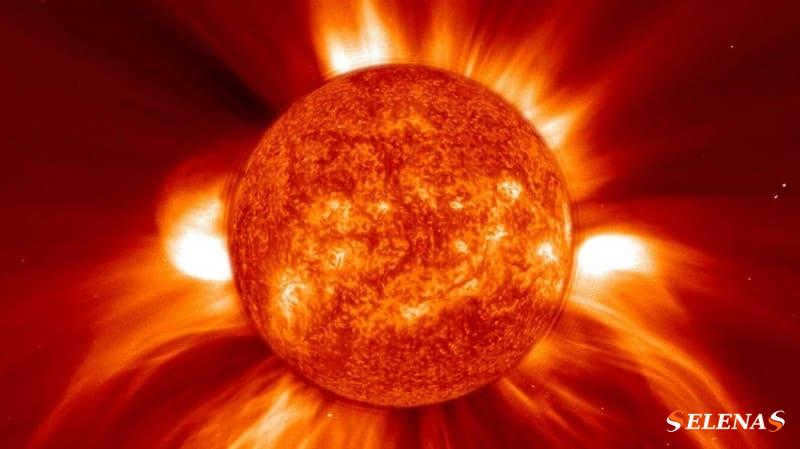
Despite the impressive speeds achieved by certain solar wind streams, it is the slower solar wind that has scientists puzzled.
“The slower solar wind poses an even greater mystery,” stated Jim Klimchuk, a solar physicist at Goddard Space Flight Center in Greenbelt, Maryland, in a statement from NASA.
NASA’s Ulysses mission, which was launched in 1990, had already provided some insights into the origin of the slow wind stream as it orbited the sun’s poles.
It discovered that during periods of low solar activity, the solar wind primarily originates from the sun’s equator.
The Parker Solar Probe is currently investigating this enigma as part of its seven-year mission to observe the sun.
“This discovery presents exciting possibilities for uncovering completely new perspectives,” stated Klimchuk.
The impact of solar wind
The influence of our tempestuous star extends throughout the entire solar system.
“I believe that when the sun experiences a gust, the Earth feels the effects because we always experience the repercussions of the sun’s activities through the solar wind,” remarked Nicky Fox, director of the Heliophysics Division at NASA Headquarters, in a NASA Science article.
On our planet, the solar wind is responsible for the mesmerizing displays of the aurora borealis in the polar regions.
In the Northern Hemisphere, this phenomenon is referred to as the northern lights (Aurora Borealis), while in the Southern Hemisphere, it is known as the southern lights (Aurora Australis).
When solar wind velocities reach certain levels, it can result in geomagnetic storms. These storms have the potential to push the boundaries of the aurora borealis further towards the equator, a phenomenon that is not typically observed during periods of less turbulent space weather.
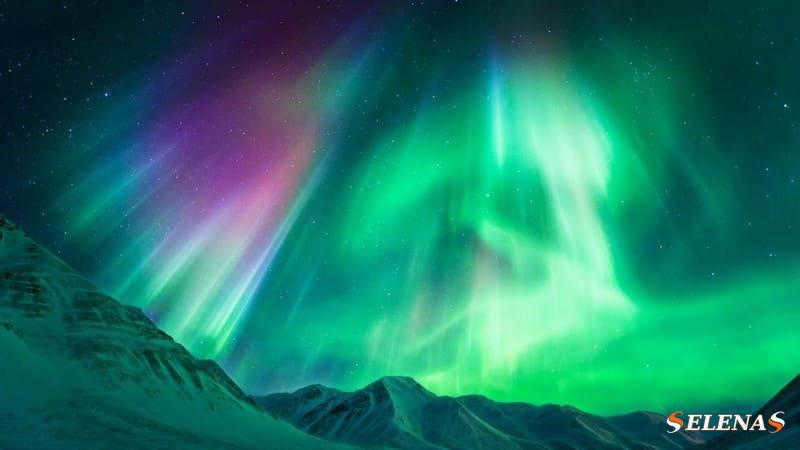
The solar wind can have significant effects on our planet, including the formation of stunning auroras like the one captured in Alaska.
Additionally, the solar wind can lead to geomagnetic storms, which can have detrimental impacts on various systems. For example, these storms can damage satellites and electrical grids, posing a threat to astronauts in space.
During such storms, astronauts aboard the International Space Station must seek shelter, spacewalks are temporarily suspended, and sensitive satellites are powered down until the radiation storm subsides.
SpaceX has experienced firsthand the destructive power of space weather. In February 2022, a geomagnetic storm caused the destruction of approximately 40 Starlink satellites, resulting in a loss of over $50 million.
Because of their low orbits, Starlink satellites need to use onboard engines to counteract drag forces and reach their final altitude of around 350 miles (550 kilometers).
When a geomagnetic storm occurs, the Earth’s atmosphere absorbs the storm’s energy, causing the thermosphere to heat up and expand. This leads to a denser thermosphere that extends from about 50 miles (80 kilometers) to approximately 600 miles (1,000 kilometers) above the Earth’s surface.
The increased density of the thermosphere results in more drag, which can pose a problem for satellites.
In February 2022, a group of recently deployed Starlink satellites encountered difficulty in overcoming the significantly heightened drag caused by the geomagnetic storm. As a result, they started descending back towards Earth and ultimately burned up in the atmosphere.
Enhancing our comprehension, monitoring, and prediction of solar weather is crucial due to its potentially expensive repercussions.
Researchers are investigating solar wind in order to gain insight into space weather and enhance space weather forecasts.
“While we cannot disregard space weather, we can implement suitable measures to safeguard ourselves,” advises NASA.
What methods do scientists use to investigate the solar wind?
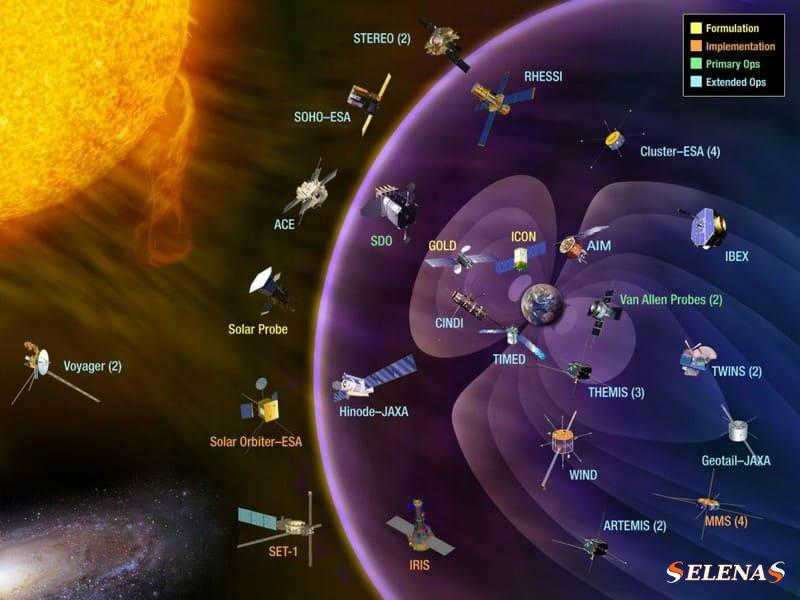
The Heliophysical System Observatory operates a group of spacecraft specifically designed for the examination of our ever-changing solar system.
Heliophysics missions are focused on researching the sun and its impact on our solar system, including the effects caused by the solar wind.
As stated by NASA, the purpose of these missions is to “comprehend everything from the formation of planetary atmospheres to the influence of space weather on astronauts and technology near Earth, as well as the fundamental physics governing our celestial surroundings.”
Gaining an understanding of the solar environment is an immense undertaking, which is why there exists a fleet of space missions dedicated to studying the behavior of our Sun.
Together, these missions can be viewed as a unified observatory known as The Heliophysics System Observatory (HSO – The Heliophysics System Observatory).
HSO is made up of a variety of spacecraft that are focused on studying the Sun, the heliosphere, geospace, and other planets. One of these spacecraft is the Parker Solar Probe, which is on a bold mission to get close to the Sun. Another spacecraft is the Solar and Heliospheric Observatory (SOHO), which is a collaboration between NASA and the European Space Agency (ESA). Additionally, there is the Solar Terrestrial Observatory (STEREO), which consists of two observatories located ahead and behind Earth’s orbit. Lastly, there is the Solar Orbiter, which is an ESA spacecraft that is exploring the previously unexplored polar regions of the Sun.
What is the impact of the solar wind on us?
A groundbreaking discovery has revolutionized our understanding of space and the solar system.
Scientists now recognize that the solar wind not only passes by Earth, but extends throughout the entire solar system and beyond.
This phenomenon has both protective and threatening effects on our planet.
“The solar wind creates a magnetic shield around the solar system, shielding Earth from high-energy particles originating from other regions of the galaxy,” explained Angela Olinto, an astrophysicist at the University of California, Chicago.
However, it also has an impact on our advanced satellite communications.
Therefore, comprehending the precise structure, dynamics, and evolution of the solar wind is vital for the progress of civilization as a whole.”
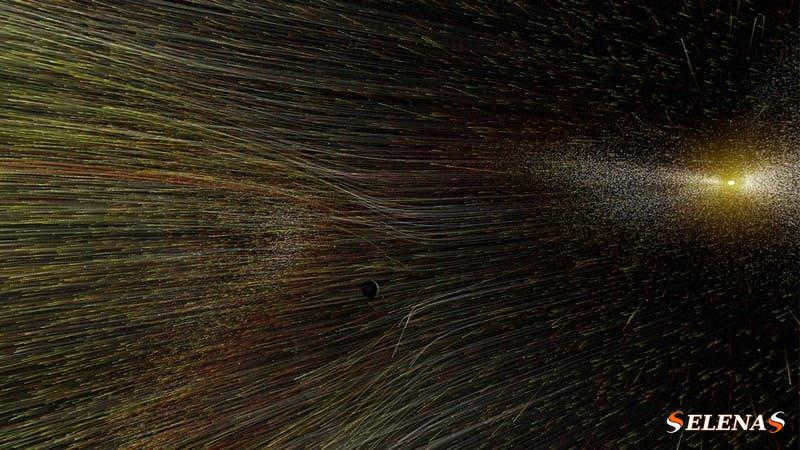
Ordinarily, the Earth’s magnetic field shields us from the majority of these particles.
However, occasionally the sun experiences a “burp” and expels billions of tons of material hurtling through space at speeds of several thousand kilometers per second.
These occurrences are known as coronal mass ejections, and if a significant ejection were to collide with the Earth, the resulting shockwave could cause widespread chaos and potentially damage our communication systems.
“It has the potential to cause the Earth’s magnetic field to resonate like a bell,” stated Professor Justin Kasper, a physicist at the University of Michigan and a graduate student at the University of Chicago.
In the past, a significant solar eruption called the Carrington Event occurred, which resulted in the disruption of telegraph and electrical systems for several days.
During this event, the Northern Lights were exceptionally intense, to the point where individuals claimed to be capable of reading newspapers at 1:00 a.m. solely by the light emitted by this natural phenomenon.
“A strange and captivating beauty could be observed on the northern horizon, as magnificent columns of light ascended, and a pinkish glow spread like smoky flames towards the sky,” described the Cincinnati Daily Commercial.
However, it’s important to note that in 1859, our reliance on electronics was not as extensive as it is today.
A study conducted by Lloyd’s of London in 2013 revealed that a storm similar to the one currently impacting Earth has the potential to cause $2.6 trillion in damage to the United States alone, resulting in extensive power outages and damage to electrical grids.
In order to take necessary precautions, engineers are eager to determine when a solar storm is approaching.
Thankfully, multiple spacecraft in orbit around the sun capture images and transmit them back to Earth, enabling NASA to monitor these eruptions.
However, analyzing these images still relies on the eruption being visible on the surface of the Sun, providing only minutes or hours of advance warning.
Currently, there is no method for predicting such eruptions before they occur.
An improved understanding of the solar wind also has implications for the field of space travel.
There are certain solar wind particles that possess an exceptionally high level of energy and have the capability to create minuscule openings in vital spacecraft machinery, not to mention the human body.
In order to safeguard astronauts, NASA must gain a comprehensive understanding of the elements, qualities, and frequencies of these particles, as well as develop the ability to forecast space weather in advance for secure space travel.
What questions are still unanswered about the solar wind?
One of the major challenges for space weather forecasters is the lack of understanding regarding the excessive heat of the Sun’s atmosphere compared to its surface.
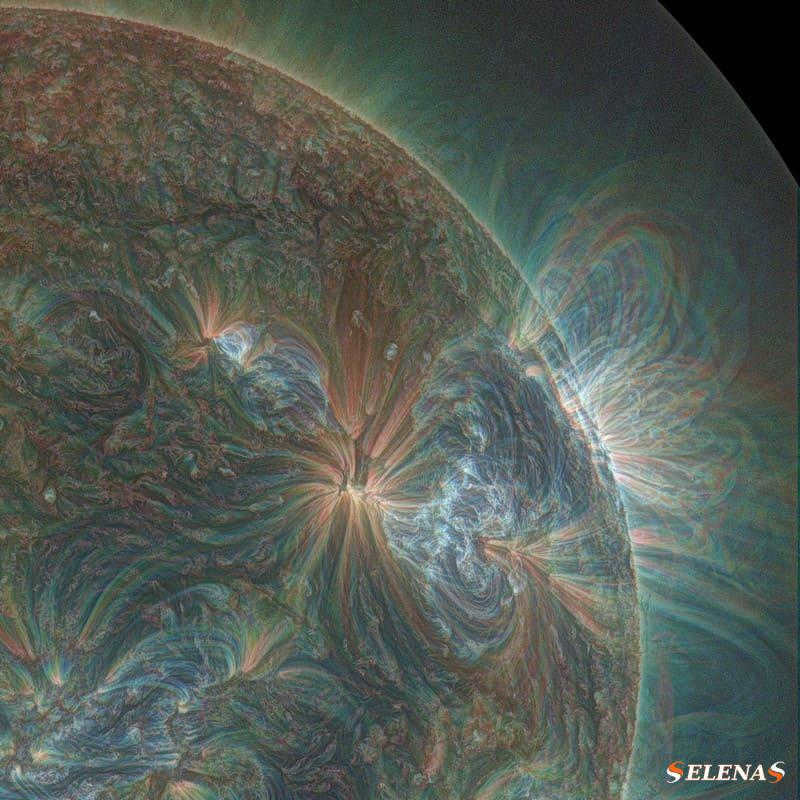

The combination of three different wavelengths of light captured by NASA’s Solar Dynamics Observatory resulted in a sequence of gradual coronal flares on January 17, 2013.
In our everyday experience, we would anticipate the temperature to progressively decrease as we move away from a source of heat, such as when we pull our hand away from a fire.
However, this is not the case with the sun.
In this instance, the heat is generated by fusion reactions occurring in the sun’s core, which gradually cools down to 6,000 degrees Fahrenheit at the surface before rising again to millions of degrees in the corona.
Various hypotheses have been put forward to explain this phenomenon.
On the surface of the Sun, there are magnetic fields that also interact – it is possible that these magnetic fields collide explosively billions of times per second, “canceling” each other out, while also causing the heating of the atmosphere.
Scientists have several questions they would like to answer:
- Why is the corona hotter than the Sun’s surface? How does the solar wind accelerate as it moves away from the Sun?
- What is the speed of particle movement and how much heat do they generate?
- Are the particles warmed by magnetic fields or are there mechanical waves originating from the Sun’s surface? (or perhaps both?)
Enhancing our knowledge of these processes could aid in forecasting the space weather that impacts life on Earth, gaining further insights into the circumstances that astronauts will encounter in orbit around our planet and during extended voyages, and even shedding light on the types of stellar activity that could influence habitability on far-off planets.
However, in order to obtain the answers, we must venture nearer to the sun itself.
What is NASA’s Parker Probe?
Ever since space travel became possible, scientists have had a strong desire to explore the Sun. Not only is the Sun crucial for life on Earth, but it is also the nearest star that we can observe and study. However, due to the extreme temperatures, scientists had to wait for the development of technology that could shield spacecraft from the intense heat and solar radiation.
In 2018, this long-awaited dream became a reality. On August 12, 2018, NASA’s Parker Solar Probe, named after Eugene Parker to honor his groundbreaking research, embarked on a seven-year mission to the scorching hot solar corona. This probe is currently the fastest man-made object, traveling at an astonishing speed of over 150,000 miles per hour. It has already completed multiple orbits around the Sun.

One year after the launch of the Parker Solar Probe, NASA scientist Nicola Fox meets Professor Emeritus Eugene Parker, the mission’s namesake, to discuss his discoveries.
The probe’s heat shield, composed of state-of-the-art carbon composite that is less than five inches thick, maintains the delicate instruments inside at a temperature of 85 degrees Fahrenheit, even as the corona discharge rages outside at a scorching 3,000,000 degrees.
With the exception of a particularly robust instrument designed by graduate student Justin Casper from the University of California at Chicago, which extends beyond the edge of the spacecraft to capture solar wind particles.
The spacecraft had already transmitted a vast amount of information back to Earth, resulting in the discovery of peculiar “back-switching” patterns in the solar wind.
At the time, Parker, who was 91 years old, traveled to Cape Canaveral with his family to witness the launch of NASA’s probe.
“So much effort was invested in that launch, and then to witness it slowly vanish – disappear into the night sky, knowing it would never return – it was an emotional experience,” Parker stated.
“Rarely does a space mission not uncover surprises, and in fact, it will become even more thrilling as the probe continues its journey and traverses uncharted territories,” Parker added.
If you have any further inquiries or would like to leave a comment regarding this article, please feel free to do so in the comments section below.
Goodbye for now! Feel free to come inside!!!
The stream of charged particles (plasma) emitted by the Sun is known as the solar wind. The flow’s velocity, density, and temperature are in a constant state of flux. The most pronounced fluctuations in these three factors occur when the solar wind exits the coronal hole or during coronal mass ejections. The flow originating from the coronal hole can be described as a steady high-speed solar wind, while the coronal mass ejection resembles a massive and fast-moving cloud of solar plasma. When these structures of solar wind reach Earth’s surface, they interact with our planet’s magnetic field. Solar wind particles can then enter our atmosphere near the magnetic north and south poles.
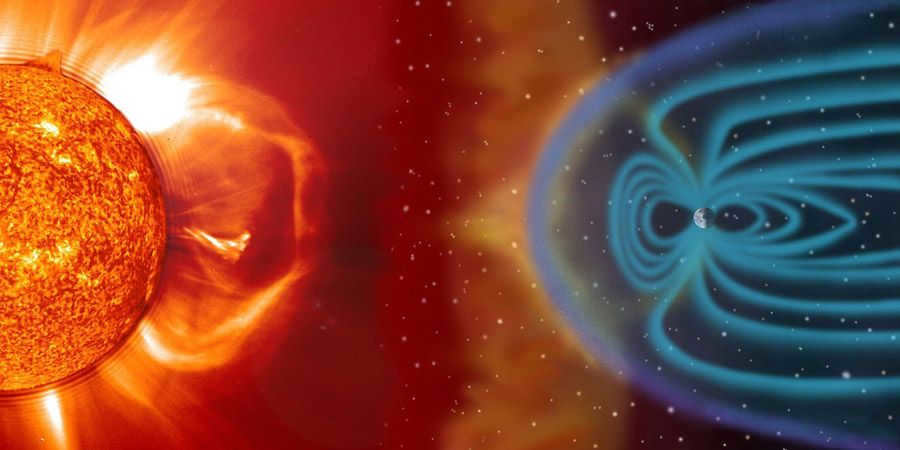

Image: A remarkable representation of the collision between the solar wind and Earth’s magnetosphere. Please note that this image is not to scale.
Speed of the solar breeze
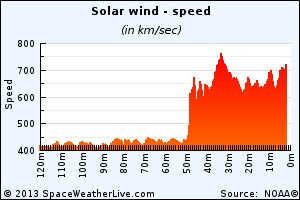
Image: It is easy to see the difference in speed in the passage of the coronal mass ejection in 2013.
Solar wind density
This parameter considers the number of particles present in each unit volume of solar wind. The occurrence of Northern Lights is more likely when there are more particles in the solar wind, as they collide with the Earth’s magnetosphere. The charts measure the number of particles per cubic centimeter or p/cm³. Values exceeding 20 p/cm³ indicate the start of a strong geomagnetic storm, but they do not guarantee the observation of any aurora. Favorable conditions also depend on the speed of the solar wind and the parameters of the interplanetary magnetic field.
Measuring Solar Wind Parameters
The website provides real-time data on solar wind and interplanetary magnetic field parameters. This data is collected by the DSCOVR Space Climate Observatory satellite, which is positioned in orbit around the Sun-Earth 1 Lagrangian point. At this specific point between the Sun and Earth, the gravitational pull from both celestial bodies is balanced, allowing the satellite to maintain a stable orbit. This location is particularly advantageous for solar projects like DSCOVR, as it enables us to measure solar wind and interplanetary magnetic field parameters before they reach Earth. Consequently, we have a time frame of 15 to 60 minutes (depending on solar wind speed) to anticipate the arrival of solar wind structures on Earth.
Image: The satellite’s precise location at the L1 Sun-Earth point.





